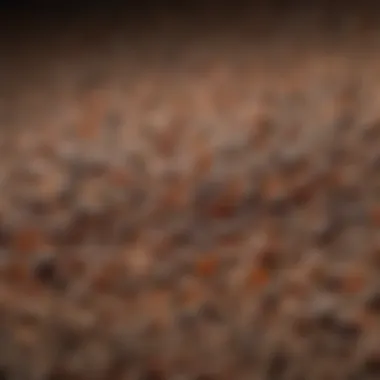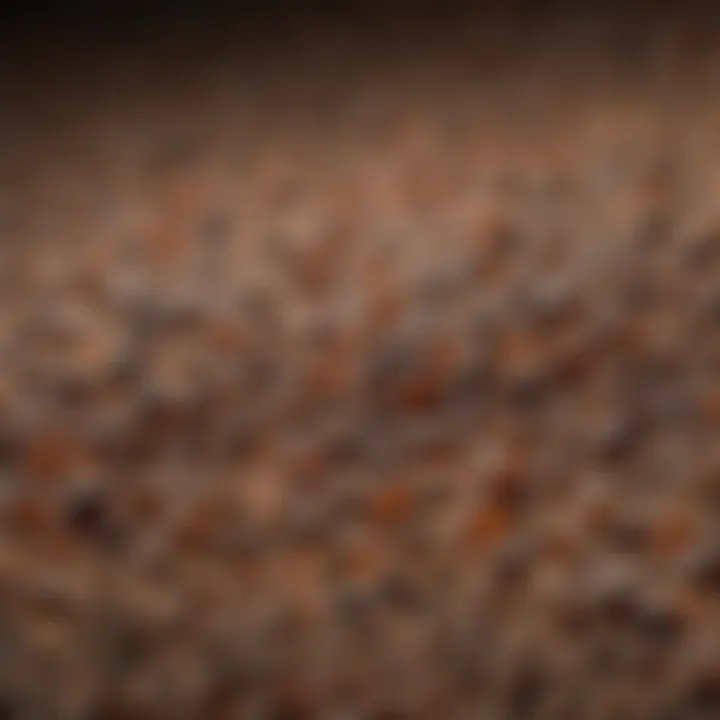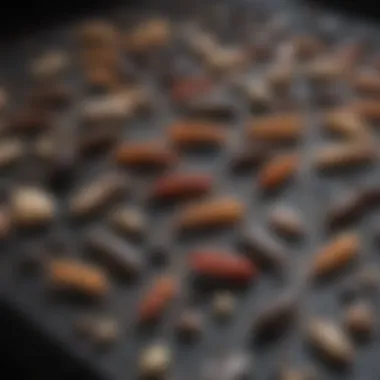Protein Ant Bait: A Strategic Approach to Ant Control


Intro
Managing ant populations in both homes and gardens can be a challenging task. Ants, as persistent pests, can invade various spaces in search of food and shelter. In recent years, the use of protein ant baits has gained traction as a highly effective method for controlling these populations. This approach is based on a deep understanding of ant behavior and the biochemical processes that drive their feeding habits.
By focusing on protein-based solutions, homeowners can tackle ant infestations in a manner that is both efficient and eco-friendly. In the following sections, we will explore the nuances of ant behavior, effective prevention techniques, and sustainable practices for pest control. The aim is to empower readers with the knowledge needed to manage ant populations without resorting to harmful chemicals or ineffective methods.
Understanding Pests
Definition of Pests
In the context of our homes and gardens, pests are organisms that interfere with human activities. They can cause damage to property, spoil food, and pose health risks. Ants are a particular concern for homeowners due to their ability to form large colonies and invade spaces quickly.
Importance of Pest Identification
Identifying specific ant species is crucial for effective control strategies. Different ant species exhibit varying behaviors, feeding habits, and nesting preferences. For instance, the behavior of a common red imported fire ant differs significantly from that of the odorous house ant. Recognizing these differences allows homeowners to select the most suitable bait and application method for their particular ant problem.
Understanding the biological and behavioral aspects of pests enhances the effectiveness of management strategies.
Prevention Techniques
Home and Garden Preventative Measures
Preventing ant invasions begins with maintaining cleanliness in your home and garden. Here are some practical measures:
- Seal Entry Points: Inspect your property for cracks and gaps that could serve as entry points for ants. Use caulk or similar materials to seal these openings.
- Proper Food Storage: Store food in airtight containers to avoid attracting ants. This includes pet food, which is often left out.
- Regular Cleaning: Keep surfaces clean from spills, crumbs, and food residues. This minimizes food sources that attract ants.
Seasonal Prevention Tips
Ant activity often fluctuates with the seasons. During warmer months, ants are more actively foraging for food. To mitigate invasions:
- Monitor for signs of ant activity during early spring and take preemptive measures.
- During fall, clean up fallen fruit and debris from gardens that may attract ants as they prepare for winter.
Eco-Friendly Pest Control Solutions
Overview of Sustainable Practices
Sustainable pest control practices aim to reduce harm to the environment while effectively managing pest populations. This includes using baits that are less toxic to non-target species and relying on biological controls when possible.
Natural Remedies and Their Effectiveness
There are various natural remedies that can be effective in repelling ants. Some of these include:
- Vinegar Solutions: A solution of vinegar and water can disrupt ant trails, making it difficult for them to navigate.
- Diatomaceous Earth: This fine powder can be sprinkled around areas where ants enter. It physically damages the exoskeleton of ants, leading to their demise.
While natural remedies can show some effectiveness, protein ant baits often offer a more decisive solution, particularly for larger infestations. By combining effective types of baits with an understanding of ant behavior, homeowners can achieve optimal results in managing ant populations.
Understanding Ant Behavior
Understanding ant behavior is crucial for anyone dealing with ant infestations. This knowledge enables effective ant control measures, particularly when using protein ant baits. By comprehending how ants choose food, communicate, and organize within their colonies, homeowners can devise strategies that resonate with the realities of ant life. This understanding can lead to more efficient management of ant populations, benefiting the home environment.
The Role of Protein in Ant Nutrition
Protein plays an essential role in ant nutrition, particularly for certain species. Ants require protein for growth, reproduction, and overall colony development. Worker ants often seek out protein sources, especially during the brood rearing period, as larvae require protein to develop. This means that protein-based baits can be highly attractive during specific times, making them an effective control strategy.
Protein sources include insects, seeds, and organic materials in nature. Ants can detect these sources through their pheromones. This natural inclination to forage for protein-rich foods can be strategically leveraged when deploying protein ant baits. Utilizing protein in bait formulation serves not only to attract ants but also to provide the nutrients necessary for brood development, increasing the chances that protein baits will be accepted by the colony.


Ant Foraging Patterns and Preferences
Ant foraging is a complex behavior influenced by various factors, including food availability and competition among colonies. Ants typically follow scent trails laid by other worker ants, directing them toward food sources. Studies show that ants exhibit preferences based on the type of food available. For instance, sugary baits may attract certain species, while protein baits have demonstrated greater effectiveness with others, especially when protein is in demand within the colony.
For homeowner strategies, observing the specific ant species can lead to more effective bait choices. Knowing their foraging patterns provides insight into the most strategic times for bait placement. Often, bait should be placed in areas where ant activity is high, as this increases the likelihood that ants will encounter and consume the bait.
Colony Structure and Development
Ant colonies are highly structured, consisting of different castes: queens, workers, and males. Each caste has specific roles that contribute to the colony’s survival. Workers are responsible for foraging, caring for the young, and maintaining the nest, while queens focus on reproduction.
Understanding this structure is important when considering bait efficacy. Protein baits can disrupt the colony’s hierarchy and development. When protein is introduced and taken back to the queen and larvae, it can affect growth patterns and the overall health of the colony. Recognizing this dynamic helps in effectively using protein baits to target the heart of the colony, not just the foraging workers.
Ant behavior is intricate, and grasping these nuances enhances the ability of homeowners to effectively manage ant populations. Through understanding protein roles in ant nutrition, their foraging patterns, and their colony structure, better decisions can be made regarding bait selection and application.
Types of Ant Baits
Understanding the different types of ant baits is crucial for effective ant management. Each type serves a unique purpose and can attract different ant species. Knowing the distinctions helps in selecting the right bait for specific infestations, which can lead to more successful control outcomes.
Sugar-Based Versus Protein-Based Baits
Sugar-based baits are generally more appealing to certain ant species that thrive on sweets, such as odorous house ants. These baits often contain sugars like sucrose or fructose. Their advantage lies in their immediate attractiveness, pulling ants towards them quickly. However, protein-based baits have their own significance. These baits, rich in proteins and amino acids, attract ants looking to support their protein requirements, especially during colony growth phases.
Choosing between these two types often depends on the specific ant species present in the environment. For instance, if an ant infestation is identified primarily by their preference for sugary substances, a sugar-based bait might suffice. Conversely, if the infestation exhibits more of a protein-based feeding habit, or during specific life cycle stages of ants, protein-based solutions become essential.
Liquid Baits versus Solid Baits
Liquid baits and solid baits represent two distinct delivery methods for ant bait formulations. Liquid baits are often easier for ants to consume and can be designed to flow easily through their foraging trails. Their fast-acting appeal means that ants can quickly gather and return back to their colonies with the bait. This can lead to effective colony control in a shorter timeframe.
Solid baits, on the other hand, offer a different set of benefits. They may last longer once placed and can withstand environmental factors such as rain better than liquid solutions. Additionally, solid baits can be formulated to release active ingredients slowly, providing a controlled feeding mechanism. However, the choice between liquid and solid forms should factor in the environment and how easily ants can access the bait.
Commercial Products Versus Homemade Solutions
Deciding between commercial ant bait products and homemade solutions can be a pivotal choice for homeowners. Commercial products are often specially formulated to include precise ratios of attractants and active ingredients. They typically undergo rigorous testing and can ensure efficacy against specific ant species. Moreover, they often carry labels with clear instructions regarding application and safety.
On the other hand, homemade ant baits can be cost-effective and allow for customization based on local ant species' preferences. For instance, a simple solution of borax and sugar can attract ants while simultaneously working as a pesticide. However, without proper knowledge, homemade solutions might lack the effectiveness of commercial products. Homeowners must weigh the benefits of convenience and reliability of commercial products against the flexibility and cost savings offered by homemade alternatives.
The Science Behind Protein Ant Baits
Understanding the science that underpins protein ant baits is crucial for effective ant control. This section elaborates on various scientific principles that enhance our comprehension of ant behavior and the effectiveness of protein baits in attracting and exterminating these pests.
Biochemical Attractants in Protein Baits
Protein baits rely on specific biochemical attractants that appeal to ants. These attractants include various amino acids and fatty acids which mimic natural food sources. The ants’ foraging instinct drives them towards these components. Research shows that worker ants are particularly responsive to certain proteins, especially during the colony's growth stages when they need additional nutrients. Using protein-rich substances, such as fish meal and gelatine, can elevate the effectiveness of bait.
When ants come into contact with these attractants, they perform a behavior known as trophallaxis. This is a process where ants share food among themselves, effectively spreading the bait throughout the colony. Such a mechanism is pivotal for managing the broader ant population as it ensures that not just a few ants are eliminated, but rather a substantial part of the colony potentially.
Mechanisms of Action in Ants
The mechanisms through which protein baits act on ants involve several physiological and behavioral responses. Upon ingestion of the protein bait, the active ingredients disrupt the ant’s normal digestion and metabolism. This is particularly relevant in bait formulations that contain insecticides carefully balanced with the protein. For example, proteins can synergize with ingredients like fipronil to enhance its lethality.
Additionally, the time it takes for ants to return to the nest after consuming the bait allows for significant distribution within the colony. Worker ants will return to their nest and share the bait with the queen and larvae. This slow-acting nature of the bait can be advantageous, as it minimizes the chances of the other ants becoming suspicious, allowing time for the bait to reach all critical members of the colony.
Pros and Cons of Protein-Based Approaches
There are several advantages to using protein-based ant baits. They are generally effective at attracting various ant species due to their nutritional appeal. Since protein is fundamental in the growth and development of ants, providing it through specially designed baits can lead to better results compared to sugar-based alternatives, especially when dealing with protein-dependent species.
However, it is essential to acknowledge potential drawbacks. One significant issue is the risk of attracting non-target species. While protein baits are formulated to target ants, other pests might also be drawn to the bait, leading to unintended consequences. Additionally, the effectiveness of these baits can be influenced by environmental conditions such as rain or high humidity, which may degrade the bait before it works effectively.


Application Strategies
The application strategies for protein ant bait play a crucial role in effectively managing ant populations. A well-thought-out approach can significantly enhance the effectiveness of the bait, ensuring that the ants consume the bait and carry it back to their colonies. This not only helps in reducing the visible ant activity but also addresses the problem at its source. Understanding the specific elements involved is essential for successful implementation.
Identifying Infested Areas
The first step in applying protein ant bait is to identify where the infestation is most severe. Ants usually follow pheromone trails laid down by other ants. By observing their movement patterns, you can pinpoint spots where they frequently appear. Common places to look include kitchens, near food storage, and outdoor areas close to entry points of the house.
Once you notice the trails, the next step is to search for signs of ant nests. Ant nests can often be found in soil, under rocks, or within the structure of your home. Use these observations to focus your bait application in areas where ants are most active. This targeted approach reduces wasted bait and maximizes its impact.
Optimal Placement of Bait Stations
Placement of bait stations is a critical element in the effectiveness of protein ant bait. After identifying the high-traffic areas, you should strategically position the bait stations. These stations need to be placed along the pheromone trails observed earlier. This way, ants are more likely to encounter the bait when foraging.
It's also beneficial to place bait in several locations rather than focusing on a single spot. You can use both interior and exterior bait stations to create a comprehensive barrier against the infestation. Ensure that these stations are hidden from direct sunlight and kept away from water sources, as moisture can compromise the bait's effectiveness.
Timing and Frequency of Bait Application
Timing is essential for the successful application of protein ant bait. Ants have specific foraging patterns, often influenced by temperature and light. Early morning or late afternoon are often the best times for placing bait, as ants are typically more active during these cooler parts of the day.
The frequency of bait application should also be considered. Initially, you may need to replace bait stations every few days to ensure they are fresh and appealing to the ants. After a few weeks of regular monitoring, you can adjust this schedule based on the activity levels observed in the infested areas.
Utilizing these strategies will not only improve the effectiveness of your protein ant bait but also contribute to a more systematic approach to ant control.
"Effective application strategies can transform ant control from a frustrating experience into a manageable task."
By focusing on these aspects, you increase your chances of successfully reducing ant populations and maintaining a pest-free environment.
Environmental Considerations
Understanding the environmental considerations surrounding the use of protein ant baits is crucial for effective ant control strategies. This area not only deals with the implications of ant management on the ecosystem but also highlights the balance between achieving pest control and protecting non-target species. Environmental awareness adds depth to the discussion about bait applications, ensuring informed decisions that benefit both homeowners and wildlife.
Impact on Non-Target Species
Using protein baits in ant control can unintentionally affect non-target species. While these baits are designed to attract and target specific ant populations, they can also lure in other insects or animals. For instance, birds or beneficial insects may be drawn to the same bait sites.
To minimize risk, it is vital to strategically place baits in locations where unintended species are less likely to encounter them. Moreover, employing bait formulations that are less attractive to non-target organisms can be beneficial. Considerations also include monitoring the bait stations regularly. This helps to ensure that bait consumption does not lead to unexpected impacts on the broader ecosystem.
Use of Organic and Eco-Friendly Baits
The ongoing shift towards organic and eco-friendly baits presents an avenue for more sustainable pest control. Homeowners can opt for protein baits that incorporate natural ingredients, reducing chemical exposure in the environment.
Organic baits typically utilize food-grade materials, making them less harmful to pets and wildlife. Not only do eco-friendly options support environmental health, but they also appeal to consumers who prioritize sustainable living. As a result, the choice of using such baits can influence public perception positively.
Benefits of using organic baits include:
- Reduced chemical runoff into soil and water bodies
- Improved safety for household pets and children
- Support for sustainable agricultural practices
Regulatory Guidelines for Bait Use
Regulatory guidelines exist to ensure the safe use of baits in different environments. Homeowners need to be aware of these regulations to ensure compliance and safe application of protein baits. Generally, regulatory bodies focus on two main aspects: ingredient safety and application methods.
These guidelines are designed to protect both human health and the environment. Baits must meet specific toxicity levels and must not harm beneficial species. Homeowners should consult local regulations or seek advice from pest control professionals regarding the best practices for applying protein baits. Resources like Wikipedia and Britannica can be helpful for broader information on this topic.
Monitoring and Evaluation
Monitoring and evaluation are crucial steps in the ant control process using protein baits. These practices not only help to assess the efficacy of the bait used but also aid in refining strategies for better pest management outcomes. By observing ant activity and analyzing results, homeowners can make informed decisions that enhance the effectiveness of their interventions. It's essential to understand that this isn't just a one-time effort but an ongoing process that requires attention and adaptability.


Assessing Bait Efficacy
To evaluate how well your protein bait is performing, begin by closely observing the areas where the bait is placed. Look for signs of ant activity, such as increased foraging around the bait station. Assessing bait efficacy involves noting the rate at which ants consume the bait and how this affects the overall ant population. Take notes on the following aspects:
- Consumption Rate: Record how quickly ants are depleting the bait. A high consumption rate typically indicates good bait acceptance.
- Population Changes: Monitor the population size over time. Reduction in visible ant activity that coincides with bait use can indicate successful control measures.
- Behavioral Changes: Changes in ant behavior can also signal the effectiveness of the bait. For example, if ants are more aggressive in foraging, it could mean they are attracted to the bait.
Collecting this data will give insight into whether to continue using the current bait or consider alternatives.
Adjusting Strategies Based on Results
Based on the assessment results, you may need to adjust your strategies. If you find that the bait is not being consumed, consider the following modifications:
- Change Bait Type: It may be necessary to switch to a different formulation or flavor that better attracts the specific ant species in your home.
- Relocate Bait Stations: If ants are not finding the bait, adjust the placement. Move stations closer to known trails or nests.
- Combine Methods: Sometimes, integrating protein bait with other forms of control, like liquid baits or gels, can enhance effectiveness.
Evaluating how changes in strategy affect ant behavior can significantly improve control measures.
Long-Term Management Planning
Long-term management planning is essential for sustainable ant control. This requires a comprehensive understanding of the ant species present and their lifecycle. Strategies should include:
- Regular Monitoring: Continue to observe the areas where you found ant activity. This will help you respond promptly to any new infestations.
- Seasonal Considerations: Different seasons can affect ant behavior and nesting patterns. Adjust strategies accordingly, perhaps increasing bait placements during peak foraging seasons.
- Integration of Baiting and Prevention: Combine bait usage with preventative measures, like sealing entry points and maintaining cleanliness in food storage, to reduce future infestations.
Ultimately, strategic monitoring and careful evaluation can turn ant baiting into an effective long-term solution in ant management.
Common Misconceptions
Understanding the common misconceptions surrounding protein ant baits is essential. These misconceptions can significantly impact the efficacy of ant control strategies. Clear identification of misunderstandings allows homeowners to make informed decisions about pest management. Many people might assume that protein baits are universally effective. Some might expect immediate results after bait application. Therefore, addressing these beliefs can prevent frustration and guide proper use of ant control measures.
Protein Baits as a One-Size-Fits-All Solution
The understanding that protein baits serve as a universal solutuion for all ant infestations is misleading. Ant species exhibit diverse behaviors and dietary preferences. Just because one ant species responds to protein baits does not mean all will. For example, sugar-loving species like the Pharaoh ant might not be attracted to protein-based options. Households must identify the ant species they are dealing with. Tailoring the bait to their specific needs increases the likelihood of success.
The Myth of Immediate Results
Households often fall into the trap of expecting prompt results with protein bait. Many assume that a few days after application, all ants will vanish. This belief overlooks the nature of ant colonies. When bait gets consumed by worker ants, it takes time to affect the queen and the rest of the colony. In practice, noticeable change may not appear for several days, or even weeks. Understanding this timeline promotes patience and prevents premature removal of bait.
Understanding Ant Resistance to Baits
Ant resistance is a growing concern for those relying on chemical or protein baits. It's not uncommon for ants to adapt to certain bait types over time. Resistance can arise from frequent exposure to the same bait ingredient, leading to decreased effectiveness. Homeowners often misconceive that switching to a different bait will always succeed. Instead, implementing a rotation of bait types might be necessary. This practice helps in managing and mitigating ant populations effectively, sustaining long-term ant control.
Future Directions in Ant Control
Understanding the future directions in ant control is crucial for homeowners and pest management professionals alike. As urban environments evolve, so do the challenges presented by ant populations. The significance of this topic lies in its potential to inform innovative strategies, ensuring effective solutions that are environmentally responsible and tailored to meet changing needs.
Innovative Research in Ant Bait Formulation
Research into ant bait formulation is progressing rapidly. Scientists focus on creating baits that are more enticing to various ant species while also ensuring they do not harm non-target organisms. For example, novel formulations utilizing ingredients such as specific amino acids or pheromones can significantly increase bait attractiveness.
The discovery of new protein sources is also part of this research. More sustainable and cost-effective options are being studied. These might include plant-based proteins or insect proteins, which provide an eco-friendlier alternative. Enhancing bait stability in diverse environments is another area of investigation.
"Innovative research is key to not only improving efficacy but also reducing environmental impact in ant control strategies."
Technological Advancements in Pest Management
Technology plays a vital role in shaping future ant control strategies. Advanced monitoring tools, such as smart traps and mobile apps, can help homeowners detect ant activity more efficiently. These tools allow for real-time tracking and provide valuable insights into ant behavior and movement.
Moreover, precision pest management technology is being developed. This includes the use of drone technology to identify infestation hotspots in larger areas. Such advancements can significantly enhance the efficiency of treatment plans while minimizing unnecessary pesticide use.
Integrating Protein Baits with Other Control Methods
A holistic approach to ant management is gaining traction. Integrating protein baits with other pest control methods can lead to improved outcomes. For example, the combination of protein baits with physical barriers or habitat modifications can reduce the likelihood of reinfestation.
Utilizing biological controls, such as introducing natural predators, can further enhance effectiveness. These complementary methods are essential for achieving long-term management of ant populations.



